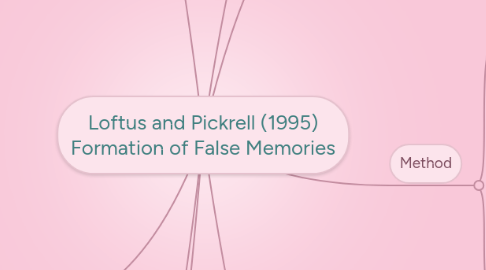
1. Procedure
1.1. Participants were told
1.2. First asked to
1.3. Two interviews
1.3.1. First
1.3.1.1. Time
1.3.1.2. what happened
1.3.1.3. Asked to
1.3.1.3.1. This type of data is
1.3.1.4. Told
1.3.1.5. Asked to rate
1.3.1.5.1. Clarity of memory
1.3.1.5.2. How confident they would be in remembering more details in time
1.3.1.5.3. This type of data is
1.3.1.6. Told to think more about events for next interview
1.3.2. Second
1.3.2.1. Time
1.3.2.2. Same procedure as first
1.3.2.3. At the end
1.3.2.3.1. Debriefed
1.3.2.3.2. Asked to
1.3.3. Conducted by
1.3.3.1. Manner
1.3.4. Where?
1.3.5. Didn't manipulate times of interviews as an IV due to...
2. Results
2.1. In total
2.2. Recall of true events
2.2.1. Across booklet, interview 1 and 2
2.3. Recall of false events
2.3.1. Booklet
2.3.2. Interview 1
2.3.3. Interview 2
2.3.4. Number resisting the suggestion of false event
2.4. Mean number of words used when recalling
2.4.1. True events
2.4.2. False events
2.4.3. This was calculated from
2.5. Mean Clarity ratings
2.5.1. True events
2.5.1.1. Interview 1 & 2
2.5.2. False events
2.5.2.1. Interview 1
2.5.2.2. Interview 2
2.6. Mean confidence ratings
2.6.1. True events
2.6.1.1. Interview 1
2.6.1.2. Interview 2
2.6.2. False events
2.6.2.1. Interview 1
2.6.2.2. Interview 2
2.7. Choosing correct false event
3. Conclusions
4. Evaluation
4.1. Quantitative data
4.2. Validity of conclusions
4.2.1. Loftus and Pickrell would argue
4.3. Quantitative data
4.4. Quantitative data
4.5. Ethics
4.5.1. Loftus and Pickrell would argue
4.5.2. Ethics
4.6. Controls
4.7. Usefulness
5. Context
5.1. Previous studies
5.1.1. Looked at proactive interference
5.1.2. Looked more at retroactive interference
5.1.3. Retroactive interference could lead to...
5.1.4. Studied by...
5.1.5. Tends to look at distorting memory of event rather than...
6. Aim
6.1. To see whether...
6.2. Based on a previous study of...
7. Method
7.1. Interviews
7.1.1. Relatives were asked
7.1.1.1. 1
7.1.1.2. 2
7.1.1.3. 3
7.1.1.4. 4
7.1.1.5. Always asked the same questions
7.1.1.5.1. Advantage
7.1.2. With participants
7.2. Questionnaire (these are also materials!)
7.2.1. In the form of
7.2.1.1. Contained
7.2.1.1.1. Stories
7.2.1.1.2. Order
7.2.1.1.3. Each page
